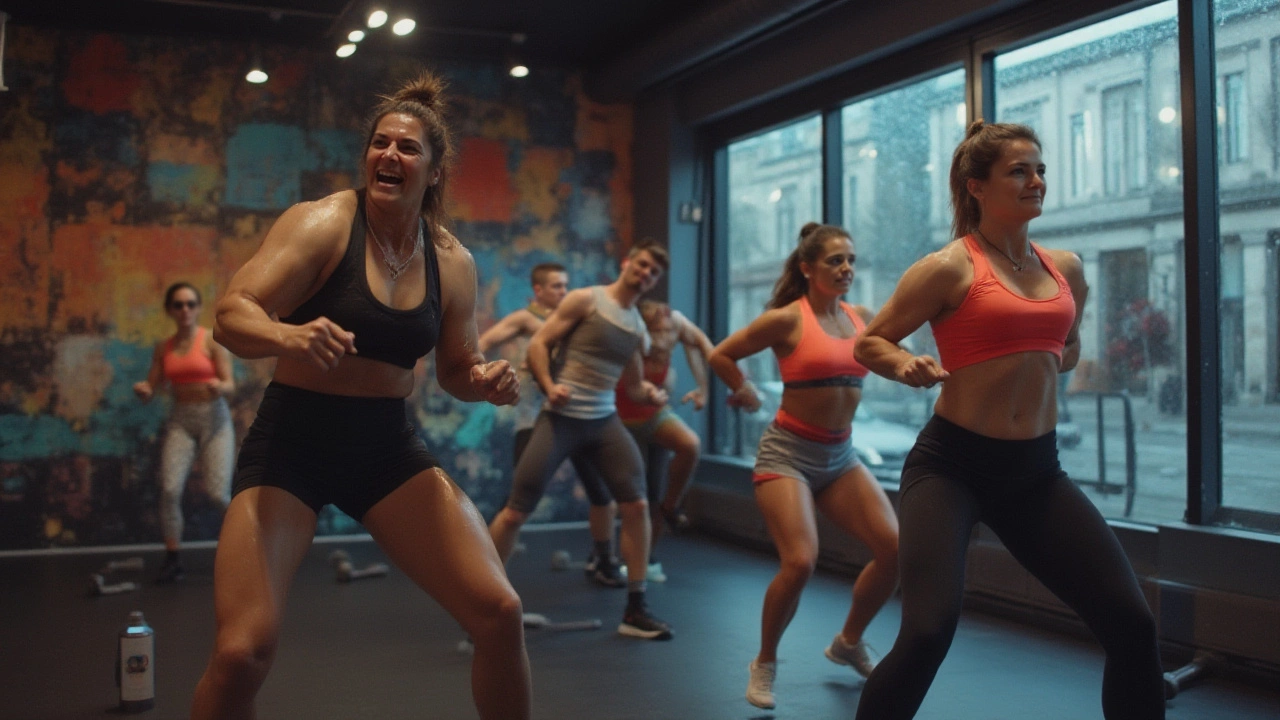
Imagine carving out just three days a week for workouts and seeing your jeans loosen up. That’s the promise of HIIT—short, intense bursts of exercise with results that rival much longer gym sessions. Some folks swear they lost ten pounds just by swapping their daily jogs for these fiery workouts. Sounds almost too good to be true, right? Let’s take a real, honest look at this: can doing HIIT three times a week help you lose weight, or is it just another fitness fad lighting up your feed?
What Exactly Is HIIT and Why Is It So Popular?
High-Intensity Interval Training, or HIIT, is like an espresso shot for your body. You push yourself really hard for a tiny chunk of time, rest, and repeat. No need to pound the treadmill for hours. A classic HIIT session can last anywhere from 15 to 30 minutes, making it perfect for people who claim they’re “too busy to work out.” Back in the early 2000s, studies out of Canada and Japan—like the famous Tabata protocol—showed that HIIT could improve heart health, speed, and power in less time than traditional cardio routines. Word spread fast, and now you’ll find HIIT workouts everywhere—from fancy boutique gyms to TikTok fitness bites.
So, why the craze? HIIT promises quick results. You sweat hard, and you might even feel like you burned a whole pizza by the end. But it’s not all hype. What sets HIIT apart is something called EPOC—excess post-exercise oxygen consumption. This means your body keeps burning calories at a higher rate even after you’ve flopped onto your couch. HIIT sessions trigger this “afterburn” more than regular, steady-state exercise. That adds up, especially if your sessions are consistent over the weeks and months.
The moves in HIIT can vary: think sprints, mountain climbers, jump squats, or burpees. You can do it with just your body weight or toss in kettlebells and resistance bands if you want to get spicy. The real secret sauce isn’t just sweating buckets—it’s pushing yourself to your edge, then letting yourself recover just long enough to go again. That ebb and flow is where the magic happens.
Is Three Days a Week of HIIT Enough to Lose Weight?
This is the burning question. A lot of people want a clear, yes-or-no answer, but human bodies are stubborn and complicated. Let’s zoom in on what the research actually shows. According to a 2020 meta-analysis published in the British Journal of Sports Medicine, individuals doing HIIT three times a week for at least twelve weeks lost an average of 1.5 kgs (about 3.3 pounds) of body fat compared to those doing moderate-intensity exercise or nothing at all. Now, this isn’t exactly a jaw-dropping, dramatic transformation, but it’s genuine, sustainable fat loss, especially for the time invested.
Keep in mind, though, that weight loss isn’t just about what you burn in a workout. You can absolutely torch calories during HIIT, but if you’re refueling with monster-sized burritos each time, your progress will stall. The calorie burn from a typical 20-minute HIIT session sits between 200-400 calories, depending on your fitness level and how hard you’re pushing. For perspective, a grande mocha from your favorite coffee shop could wipe out that deficit quickly. So, yes, HIIT is super efficient for burning fat, thanks especially to that EPOC effect, but your diet and daily habits play a massive supporting role.
Why three times a week? It’s enough to let your body recover, which is crucial. HIIT is intense—do it every day and you’ll burn out or, worse, hurt yourself. Most fitness coaches recommend alternating rest (or lower-intensity) days between sessions to protect your muscles and joints. Real stories back this up: people who stick to three focused sessions report better consistency and less risk of quitting than folks trying to go all-out five or six days a week.
Looking at the numbers, HIIT makes sense for busy people who want noticeable results without living at the gym. Here’s some quick data to back it up:
| Workout Type | Calories Burned (20 mins) | Recommended Weekly Sessions | Fat Loss Potential (3 months) |
|---|---|---|---|
| HIIT | 200-400 | 3 | 1-3 kg |
| Jogging | 120-180 | 3-5 | 0.5-2 kg |
| Strength Training | 100-160 | 3-5 | 1-2 kg |
If you’re shooting for fat loss, three HIIT sessions per week can make a noticeable dent in the scale—if you don’t undo the work with extra calories.

Tips to Get the Most Out of Your HIIT Sessions
Doing HIIT isn’t as simple as winging it with ten burpees and calling it a day. If you want results (and to avoid injury), a little strategy goes a long way. Here are some tips that actually work, from coaches and HIIT junkies alike:
- Warm up every time. Your joints and muscles need a heads-up before you hit hard intervals. A quick 5 minutes of dynamic stretching or jogging is golden.
- Set a timer. HIIT is all about time or reps. Apps like Seconds or HIIT Timer help keep you honest and focused.
- Mix up your moves. Alternate between upper body, lower body, and full-body exercises to keep things balanced and interesting. Think squat jumps one round, push-ups the next, then some sprints.
- Pick intervals wisely. The sweet spot is 20-40 seconds of all-out work followed by 10-60 seconds of rest. Too little rest and your form will crumble, which risks injury.
- Don’t skip recovery. On rest days, active recovery like brisk walking or gentle yoga helps reduce soreness and speeds healing.
- Stay hydrated. HIIT can leave you drenched. Water carries nutrients to muscles and keeps you sharp during those intense bursts.
- Document your workouts. Seeing your progress—like adding more reps or shaving seconds off your rest—keeps you fired up.
Here’s a super-sharp trick: throw in a “finisher” round. After your main intervals, set a timer for 1-2 minutes and repeat your favorite move (like mountain climbers) until the buzzer sounds. That last push ignites extra fat burn and leaves you buzzing with a job well done.
And don’t underestimate sleep. Your body repairs, builds muscle, and recovers during sleep. If you’re not getting at least 7 hours most nights, no workout plan will save you.
Your Diet: The Hidden Player in HIIT Weight Loss
Even the fiercest HIIT routine can’t outsmart a diet that’s out of whack. Think of HIIT as the accelerator, but your food choices are the steering wheel. If you’re piling your plate with takeout and soda, don’t expect HIIT alone to do all the heavy lifting. The magic combo? A balanced diet packed with lean protein, colorful veggies, healthy fats, and just enough carbs to fuel your sessions.
Tracking your food for a week—either by journaling or using a food app—can be a game changer. People are often shocked to realize how many “hidden” calories they down with snacks or extra-large lattes. Aim for a gentle calorie deficit: 300-500 calories less than your maintenance needs per day is a proven path for sustainable, long-term weight loss. More than that and you risk feeling tired, cranky, and more likely to skip workouts.
Don’t skip breakfast the day after HIIT, expecting to burn more fat. Studies from the University of Bath in the UK show that eating a balanced meal post-workout helps muscles recover and actually boosts your metabolism. Your muscles need protein after those high-intensity intervals. Greek yogurt, eggs, or a protein shake are fast and effective.
If you’re stumped about meal planning, try this approach:
- Pre-load your fridge with chopped veggies and cooked protein like chicken or tofu.
- Keep healthy snacks like nuts or hummus handy for post-HIIT hunger attacks.
- Have carb sources like oats or sweet potato ready for days you’re feeling drained.
Drinking enough water is another overlooked tip—being even a little dehydrated can sap your energy and slow recovery. For those who like numbers, aim for at least half an ounce of water per pound of body weight per day, more when you sweat buckets.

Common HIIT Mistakes and How to Dodge Them
It’s easy to get caught in the hype and forget that HIIT done wrong can backfire. Here are real pitfalls to watch out for:
- Going 100% every single session. That backfires fast. Listen to your body: fatigue and joint pain mean take a lighter day.
- Ignoring form. Chasing speed or reps at the cost of proper technique is a shortcut to injury. Always trade a perfect squat over a fast, sloppy one.
- Shortchanging rest. Your body needs 48 hours to rebuild between high-intensity sessions. Fill the gaps with walking or mobility work.
- Repeating the same workout forever. Variety is key. Swap exercises every couple of weeks to challenge different muscle groups and prevent boredom.
- Forgetting to track progress. If you don’t know how you’re improving, you’ll lose motivation—and probably plateau.
- Overestimating calorie burn. It’s tempting to “reward” yourself with treats after a tough HIIT session, but you can eat back your deficit quickly.
- Skipping cooldowns. Cooling down after intervals helps clear lactic acid and reduces soreness. Five minutes really does make a difference.
There’s also the trap of comparing yourself to fitfluencers. Your starting point, body composition, and metabolism all matter. Two people can do the same workout and see totally different results. Stay focused on your own goals, and celebrate small wins—like shaving ten seconds off your sprint or adding a round to your circuit.
One other rookie mistake: putting HIIT on autopilot. Your mind can wander if you know the routine by heart. Challenge yourself by adding new moves or adjusting your interval times to keep things fresh. This keeps both your body and brain dialed in.
